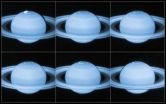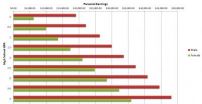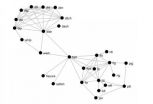(Press-News.org) University of Leicester researchers have captured stunning images of Saturn's auroras as the planet's magnetic field is battered by charged particles from the Sun.
The team's findings provide a "smoking gun" for the theory that Saturn's auroral displays are often caused by the dramatic collapse of its "magnetic tail".
Just like comets, planets such as Saturn and the Earth have a "tail" – known as the magnetotail – that is made up of electrified gas from the Sun and flows out in the planet's wake.
When a particularly strong burst of particles from the Sun hits Saturn, it can cause the magnetotail to collapse, with the ensuing disturbance of the planet's magnetic field resulting in spectacular auroral displays. A very similar process happens here on Earth.
University of Leicester scientists observed this process happening on Saturn firsthand between April and May of 2013 as part of a three-year-long Hubble observing campaign. Their findings have been accepted for publication in Geophysical Research Letters, a journal of the American Geophysical Union.
The ultraviolet images, taken by Hubble's super-sensitive Advanced Camera for Surveys, capture moments when Saturn's magnetic field is affected by bursts of particles streaming out from the Sun.
Due to the composition of Saturn's atmosphere, its auroras shine brightly in the ultraviolet range of the electromagnetic spectrum. This observation campaign using Hubble meant the astronomers were able to gather an unprecedented record of the planet's auroral activity.
The team caught Saturn during a very dynamic light show. Some of the bursts of light seen shooting around Saturn's polar regions travelled at over three times faster than the speed of the gas giant's rotation.
"These images are spectacular and dynamic, because the auroras are jumping around so quickly," Dr Jonathan Nichols, of the University of Leicester's Department of Physics and Astronomy, who led the Hubble observations, said.
"The key difference about this work is that it is the first time the Hubble has been able to see the northern auroras so clearly.
"The particular pattern of auroras that we saw relates to the collapsing of the magnetotail," he added. "We have always suspected this was what also happens on Saturn. This evidence really strengthens the argument."
"Our observations show a burst of auroras that are moving very, very quickly across the polar region of the planet. We can see that the magnetotail is undergoing huge turmoil and reconfiguration, caused by buffering from solar wind," Nichols said. "It's the smoking gun that shows us that the tail is collapsing."
The new images also formed part of a joint observing campaign between Hubble and NASA's Cassini spacecraft, which is currently in orbit around Saturn itself.
Between them, the two spacecraft managed to capture a 360-degree view of the planet's aurora at both the north and south poles. Cassini also used optical imaging to delve into the rainbow of colours seen in Saturn's light shows.
On Earth, observers of auroras see green curtains of light with flaming scarlet tops. Cassini's imaging cameras reveal similar auroral veils on Saturn, which are red at the bottom and violet at the top.
INFORMATION: END
'Smoking gun' evidence for theory that Saturn's collapsing magnetic tail causes auroras
Saturn's auroras are caused by the same phenomenon which leads to dramatic auroral displays on Earth, University of Leicester research shows
2014-05-19
ELSE PRESS RELEASES FROM THIS DATE:
Solar energy prospects are bright for Scotland, experts say
2014-05-19
Installing state-of-the-art solar panels on a quarter of a million roofs could meet one-sixth of Scotland's electricity demands, experts say.
Scientists say the strategy could ease the plight of one in three Scottish households, which currently struggle to provide themselves with adequate heat and hot water.
Researchers, business leaders and public sector experts have contributed to a report which sets out how Scotland could benefit from solar power.
They say harnessing energy from the sun on the roofs of south-facing buildings could have significant economic, ...
Antarctica's ice losses on the rise
2014-05-19
Three years of observations show that the Antarctic ice sheet is now losing 159 billion tonnes of ice each year – twice as much as when it was last surveyed.
A team of scientists from the UK Centre for Polar Observation and Modelling, led by researchers at the University of Leeds, have produced the first complete assessment of Antarctic ice sheet elevation change.
They used measurements collected by the European Space Agency's CryoSat-2 satellite mission, which carries an altimeter specially designed for this task.
In sharp contrast to past altimeter missions, CryoSat-2 ...
Sanofi Pasteur announces favorable Phase II data for investigational C. difficile vaccine
2014-05-19
Boston, United States of America – May 19, 2014 – Sanofi Pasteur, the vaccines division of Sanofi (EURONEXT: SAN and NYSE: SNY), presented Phase II (H-030-012) trial results for an investigational vaccine for the prevention of Clostridium difficile (C. diff) infection (CDI) at the 114th General Meeting of the American Society for Microbiology (ASM). The Phase II trial met its primary objectives, reactions were generally mild and of short duration, and the candidate vaccine generated an immune response against C. diff toxins A and B. These toxins are largely responsible ...
Your high school GPA could affect your income
2014-05-19
Coral Gables, Fla. (May 19, 2014)—A team of researchers led by Michael T. French, professor of health economics at the University of Miami (UM), finds that high school grade point average (GPA) is a strong predictor of future earnings.
The findings, published recently in the Eastern Economic Journal, show that a one-point increase in high school GPA raises annual earnings in adulthood by around 12 percent for men and 14 percent for women.
Although previous studies have found a relationship between higher levels of education and greater earnings, less is known about ...
Keywords hold vocabulary together in memory
2014-05-19
Much like key players in social networks, University of Kansas scientists have found evidence that there are keywords in word networks that hold together groups of words in our memory.
In a study published in the Journal of Memory and Language, Michael Vitevitch, KU professor of psychology, showed that research participants recognized these keywords more quickly and accurately than other words that were like the keywords in many respects except for their position in a network of 20,000 similar-sounding English words that he and colleagues created in 2008.
"If words ...
National heart organizations join to combat the global hypertension epidemic
2014-05-19
NEW YORK, N.Y., May 19, 2014: It's estimated that more than 970 million people have hypertension1 and, globally, the disease is responsible for more than nine million deaths every year, making it one of the leading causes of death worldwide. In an effort to help manage the epidemic, leading scientists from the American Society of Hypertension (ASH), American Heart Association (AHA) and the Centers for Disease Control and Prevention (CDC) convened a joint panel to discuss a global project aiming to improve the treatment and control of hypertension worldwide.
The joint ...
IN-TIME shows equal benefit of home telemonitoring in ICD and CRT-D patients
2014-05-19
Athens, 19 May 2014: Home telemonitoring is equally effective in ICD and CRT-D patients, a subanalysis of the IN-TIME trial has shown. The findings were presented for the first time today at the Heart Failure Congress 2014, held 17-20 May in Athens, Greece. The Congress is the main annual meeting of the Heart Failure Association of the European Society of Cardiology.
The prospective IN-TIME multicentre trial included 664 patients with chronic heart failure, class II or III New York Heart Association (NYHA) symptoms and left ventricular ejection fraction END ...
Novel device successfully treats central sleep apnea in heart failure
2014-05-19
Athens, 19 May 2014: A novel device implanted under the skin like a pacemaker successfully treats central sleep apnoea (CSA) in heart failure patients, according to research presented today at the Heart Failure Congress 2014, held 17-20 May in Athens, Greece. The Congress is the main annual meeting of the Heart Failure Association of the European Society of Cardiology.
The one year results of the remede® system pilot study were revealed for the first time by lead author Professor William T. Abraham from the Ohio State University. He said: "The remede® system is the first ...
Solution to helping teens with chronic disease may be at fingertips
2014-05-19
Adolescents with chronic diseases (ACD), such as cystic fibrosis, gastrointestinal disorders (including Crohn's disease) and Type 1 diabetes, often find the transition of managing their health care needs into adulthood to be challenging. Preparations for this transition are often clinic-based, costly and do not fully or effectively engage with this patient population. A new study by researchers at the University of California, San Diego School of Medicine found the answer to developing independent, self-management skills in ACD could be right at the patient's fingertips. ...
Chronic insufficient sleep increases obesity, overall body fat in children
2014-05-19
One of the most comprehensive studies of the potential link between reduced sleep and childhood obesity finds compelling evidence that children who consistently received less than the recommended hours of sleep during infancy and early childhood had increases in both obesity and in adiposity or overall body fat at age 7. The study from MassGeneral Hospital for Children (MGHfC) investigators, published in the June issue of Pediatrics, also finds no evidence of a specific period during which insufficient sleep has greater influence on later obesity.
"Our study found convincing ...
LAST 30 PRESS RELEASES:
New study overturns long-held model of how plants coordinate immune responses.
New AI model predicts disease risk while you sleep
Scientists discover molecular ‘reshuffle’ and crack an 80-year-old conundrum
How stressors during pregnancy impact the developing fetal brain
Electrons lag behind the nucleus
From fungi to brain cells: one scientist's winding path reveals how epigenomics shapes neural destiny
Schizophrenia and osteoporosis share 195 genetic loci, highlighting unexpected biological bridges between brain and bone
Schizophrenia-linked genetic variant renders key brain receptor completely unresponsive to both natural and therapeutic compounds
Innovative review reveals overlooked complexity in cellular energy sensor's dual roles in Alzheimer's disease
Autism research reframed: Why heterogeneity is the data, not the noise
Brazil's genetic treasure trove: supercentenarians reveal secrets of extreme human longevity
The (metabolic) cost of life
CFRI special issue call for papers: New Frontiers in Sustainable Finance
HKU Engineering scholar demonstrates the smallest all-printed infrared photodetectors to date
Precision empowerment for brain "eavesdropping": CAS team develops triple-electrode integrated functional electrode for simultaneous monitoring of neural signals and chemical transmitters during sleep
Single-capillary endothelial dysfunction resolved by optoacoustic mesoscopy
HKU three research projects named among ‘Top 10 Innovation & Technology News in Hong Kong 2025’ showcasing excellence in research and technology transfer
NLRSeek: A reannotation-based pipeline for mining missing NLR genes in sequenced genomes
A strand and whole genome duplication–aware collinear gene identification tool
Light storage in light cages: A revolutionary approach to on-chip quantum memories
Point spread function decoupling in computational fluorescence microscopy
BacPhase: Long-insert paired-end sequencing for bin marker construction and genome phasing
GmWOX1 regulates the mediolateral polarity of compound leaves in soybean
ChargeFabrica: An open-source simulation tool that aims to accelerate search for high performance perovskite solar cells
High levels of ADAR overexpression induce abundant and stochastic off-target RNA editing in rice protoplasts
On-demand upgraded recycling of polyethylene and construction of sustainable multifunctional materials based on the "LEGO" strategy
New "Stomata in-sight" system allows scientists to watch plants breathe in real-time
Anorexia nervosa may result in long-term skeletal muscle impairment
Narrative-based performance reviews deemed fairest by employees
New insights reveal how advanced oxidation can tackle emerging water pollutants
[Press-News.org] 'Smoking gun' evidence for theory that Saturn's collapsing magnetic tail causes aurorasSaturn's auroras are caused by the same phenomenon which leads to dramatic auroral displays on Earth, University of Leicester research shows


